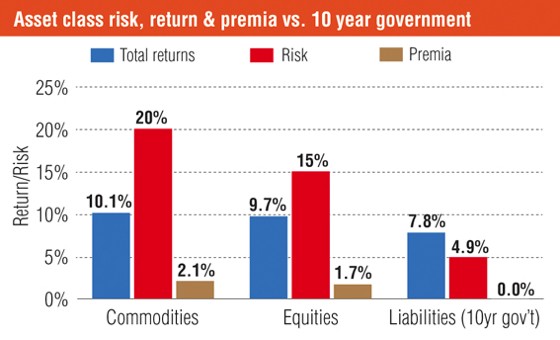Investing in Commodities Diversification or Hedging
Post on: 25 Апрель, 2015 No Comment

Why invest in commodities? One of the main reasons to invest in commodities is the diversification of ones portfolio, which normally would include mainly investments in stocks and bonds. It is taken for granted by the investor community that there is no correlation between the price of stocks and bonds and the price of commodities, and therefore the investment in commodities serves as a real diversification tool. However, in case there is a negative correlation between the price of stocks and bonds and the price of commodities, which means they are going in opposite directions, investing in commodities could also serve as a hedging tool, protecting from declines in the equity market and the bond market.
In order to find out which kind of correlation exists or does not exist between the price of stocks and bonds and the price of commodities, we have conducted a thorough study to investigate the correlation in the last 50 years: this period has been divided in 5 year periods, and the correlation for each period has been checked. Some results of the study appear in the tables below, and it is shown that results differ from period to period.
Study 1: Stocks Index vs. Commodities Index
The end of the month values of two indexes, Dow Jones Industrial stocks Index and Reuters CRB commodities Index, were taken; and the coefficient of correlation r was calculated. The level of significance to assume if there was correlation between the two indexes was set for this test at 1%, which means that for sample size of 60 months r should be greater than 0.325 for positive correlation or smaller than -0.325 for negative correlation (0.449 for sample size of 30).
The Dow Jones Industrial Index. the average consists of 30 of the largest and most widely held public companies in the United States.
The Reuters CRB commodities Index consists of 19 different commodities in equal proportions.
click to enlarge images
Conclusions drawn from study 1
There were 5 periods of 5 years in the 52 years time range in which there was no correlation between the price of stocks and the price of commodities, and investing in commodities during these periods could be considered as diversification tool for stocks portfolio.
There were another three 5 years periods showing a negative correlation, which means that stock price and commodities went in opposite direction, and investing in commodities during these periods could be considered a hedging tool against stock market decline.
Three periods showed a positive correlation between the price of stocks and the price of commodities, which means that stock price and commodities went in the same direction, and investing in commodities during these periods could not be considered a diversification or hedging tool for the stock market. This does not mean that commodities during these periods could not account for a great investment, it just goes to show that commodities price pattern was in the same direction of the stock market.
Study 2: Stocks Index vs. Oil Price
In this study, the end of the month values of Dow Jones Industrial Index and oil price were taken, and the coefficient of correlation r was calculated.
Conclusions drawn from study 2
There were 5 periods of 5 years each in the 52 years time range in which there was a negative correlation between the price of stocks and the price of oil. This result makes sense, since the elevated price of oil is an obstacle to economic growth.
Nevertheless, there were 2 periods showing positive correlation between the price of oil and the price of stocks, and in the years 1986-1990 there was upside pattern for both prices.
There were also 4 periods with no correlation between the price of stocks and the price of oil.
Study 3: Commodity Index vs. US$/Euro Exchange Rate
In this study, the end of the month values of the Reuters CRB commodities Index and the exchange rate between US dollar and the Euro were taken, and the coefficient of correlation r was calculated (since the euro currency was launched on 01-01-1999, calculated theoretical values were considered between 1956 to 1999).
Conclusions drawn from study 3
Most of the periods showed a negative correlation between the commodity index and the dollar value relative to the euro. These results are not surprising, since commodities prices are expressed in dollars, and the weak dollar pushes commodities prices upward.
Conclusion
In summary, we have shown that the well accepted conception that commodities can act as a diversification tool of an investment portfolio, because their price is not correlated to the price of the stock market, applies only to certain periods.
There were periods when commodities prices went in the same direction as the stock market and did not give any diversification benefit, and there were periods when commodities prices went in the opposite direction to the stock market, and could then serve as a hedging tool against the decline in the stock market.
The commodities themselves could be either a great or lousy investment; it all depends on the basic fundamentals of supply and demand, and on the speculative activity of the traders.














